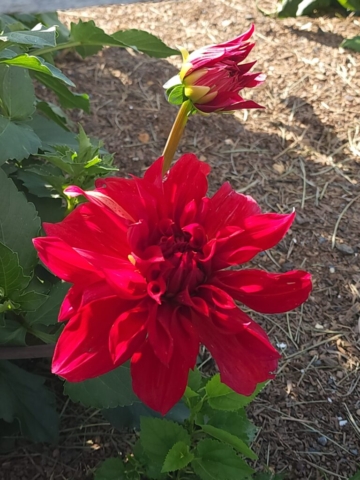French poet, Paul Verlaine, describes my new preferred bloom magnificently in his poem, “Un Dahlia”, or “The Dahlia”. He writes: “Ainsi le Dahlia, roi vêtu de splendeur...” (12) or “Thus the dahlia, king dressed in splendor…” (12).
This description, sounding, oh, so much more beautiful when recited in French than in English, precisely describes my new favorite flower, the king of the garden, the dahlia. The king, now, ties his bride, the rose, for the number one spot on my favorite flower list.
Because the power of a garden comes from its ability to appeal to a visitor’s senses, the king and queen are essential actors. With both of them working their magic in tandem, they enthrall all who enter their court.
How do the king and queen appeal? First, by sight. The king, with his bold, sometimes, almost loud, colors, commanding size, and geometric shape, quickly draws a newcomer’s eyes while his mate’s more subdued organic blooms take another moment to attract. Second? By smell. The king, with little to no fragrance to call his own stands idly by while his wife, weaving her whimsical witchcraft, entices all newfound travelers with her musky and slightly fruity fragrance.
Now that I’ve settled who is at the top of my list of favorite flowers and briefly explained why, where did this king, the dahlia, come from? Well, with all this talk about kings and queens, one might assume the dahlia to be a European original. Did the king, in fact, come from Spain, the Netherlands, Italy, Germany, Belgium, Switzerland, or France?
No, el rey es de México y partes de América Central…
That’s right, no, the king comes from Mexico and parts of Central America. So proud, in fact, to call the king her own hijo, Mexico designated the dahlia as her national flower in 1963.
In spite of the king, though, being proud of his Central American roots, I am quite certain that the late poet Paul Verlaine would commend Empress Josephine Bonaparte for being the one to have sponsored the American king’s first trip from lovely Mexico to France during the nineteenth century.
Did the empress kidnap the king and keep him in France after the royal stepped onto those sandy French shores, or did he venture elsewhere? Eventually, the king, searching for new homes to add to his estate, called on other European courts. During his stay in England, for example, with her long and enduring history of kings and queens and her people’s steadfast appreciation of horticulture, the king began constructing a new manor for his family, and, as time progressed, the list of properties that he and his wife acquired continued to grow.
But today, where is the legendary couple and how are they doing?
With over forty-two species of dahlias ranging in various sizes and hues reigning in gardens throughout the world, the dahlia and the rose rule internationally. They decorate gardens throughout the world and are, as can be expected, doing quite well.
Having ignorantly chosen to let the queen run her court by herself in my humble gardens, here in Maryland, I failed to fashion the most alluring plot possible until this season. Now, though, after recognizing the errors of my ways, my garden court will never be incomplete again. From now on, my queen will always stand next to her king.
Both the dahlia and the rose should be at the top of every gardener’s favorite flower list. They certainly, now, are on mine.






